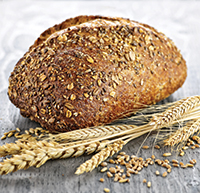
The obesity buzz
October 31, 2011
By
Brandi Cowen
More than 1,000 individuals and organizations – representing youth,
child-care providers, national aboriginal organizations, industry, media
and non-governmental organizations – participated in the “Our Health
Our Future” national dialogues on healthy eating and obesity.

|
|
| The Baking Association of Canada found that many Canadians are falling short of their grain requirements.
|
More than 1,000 individuals and organizations – representing youth, child-care providers, national aboriginal organizations, industry, media and non-governmental organizations – participated in the “Our Health Our Future” national dialogues on healthy eating and obesity. During the consultations, Canadians and government officials discussed the range of factors that can lead to obesity, and explored ideas to tackle the country’s obesity epidemic and promote healthier eating.
The Baking Association of Canada (BAC) was one of several industry groups to participate in the consultations. In its representation to the Public Health Agency of Canada (PHAC), the BAC highlighted the efforts Canada’s bakers have made to improve the nutrition of their products, noting that birth defects have dropped since the industry began fortifying foods and ingredients with thiamine, riboflavin, niacin and folic acid. The BAC also pointed to the industry’s participation in voluntary initiatives to cut levels of sodium and trans fats in bakery products.
Moreover, in its submission, the BAC noted that in 2004, approximately 25 per cent of Canadian children between the ages of four and eight did not eat enough grain – a figure that tends to rise with age. Approximately 30 per cent of adults failed to reach the five-serving minimum recommended in the previous version of Canada’s Food Guide to Healthy Eating. According to the BAC, the number of Canadians who are falling short of the new recommended servings of grain-based products – updated to six servings for teens and adult women, and seven servings for adult men in the 2007 edition of the food guide – is likely to be even higher now.
BAC president and CEO Paul Hetherington says one thing the association would like to see come from the healthy eating and obesity consultations is an acknowledgment of the importance of grain-based products in a healthy lifestyle.
“I think an important outcome would be the recognition of the value of grain-based products to a balanced diet,” says Hetherington. “We look at the contribution that grains make to the diet as being very important, particularly as it relates to whole grains, and there’s ample clinical evidence to support that position.”
Another key outcome, from the BAC’s perspective, will be driving home the idea that healthy diets leave room for the occasional treat.
“The challenge in all of this is taking an approach that is balanced. All foods can be consumed as part of a healthy diet – it’s an issue of selection. I can enjoy a piece of cake as part of a healthy diet, as long as I recognize that I’m consuming cake now, so I have to moderate my diet to account for the fact that I’m eating cake,” says Hetherington.
The issues raised in the BAC’s representation to PHAC will be folded into a broader report on the national dialogues as a whole. That report was due to be presented to the federal, provincial and territorial health ministers last month. Although it was not available at press time, PHAC states that the goal of the report is to identify actions that can be taken to address childhood obesity and help all Canadians reach and maintain healthy weights.
“The goal in launching the national dialogue was to kick-start the discussion, generate ideas and facilitate collaboration across a range of sectors that have an interest in this issue,” says Charlene Wiles, media relations advisor with PHAC.

|
|
| Ideally, the report will recognize that a little moderation goes a long way in making room for all foods in a healthy diet.
|
“Addressing obesity includes changing the social and physical environments that influence children’s and families’ eating habits and activity levels. To do this, a variety of actions from all sectors of society are needed – governments alone cannot address the growing obesity epidemic. We all have a role to play to promote healthy weights and keep our children healthy,” she adds.
However, Wiles says that PHAC recognizes “individuals have a role to play in their own health and well-being,” noting that staying physically active and maintaining a healthy weight are “essential to good health.”
So what can we expect to see in the report?
Some groups have floated the idea of introducing a tax on unhealthy foods, as Denmark did last month. Perhaps most notably, in March, the Canadian Medical Association called on the federal government to tax sugar-sweetened drinks.
But from where Hetherington sits, Canada doesn’t appear poised to follow Denmark’s example anytime soon. “I think the reality is that those types of interventions have yet to be proven that they actually contribute to anything other than government coffers,” he says.
Other initiatives, such as limiting how foods and beverages high in fat or sugar are marketed to children, are up for discussion, according to Wiles.
From 2007 to 2009, approximately 24.1 per cent of Canadians over the age of 30 were obese, according to Statistics Canada’s Canadian Healthy Measures Survey. During that same period, the national childhood obesity rate sat at 8.6 per cent. Obesity rates have been on the rise for the past 20 years, according to data collected by Statistics Canada.
Fast facts
Sources: Statistics Canada and Government of Canada |
||
Print this page
Leave a Reply